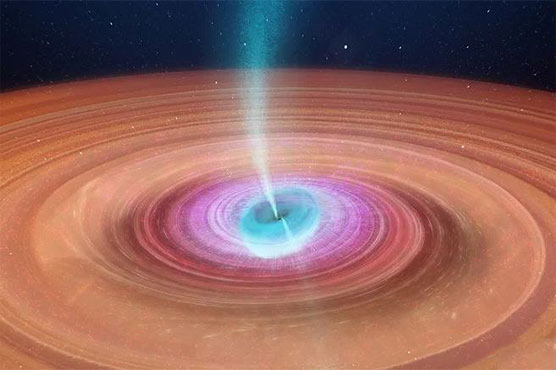Black hole shoots out wobbly jets, dragging space and time

The research has been published in the Nature.
(Web Desk) – Some 7,800 light-years away, in the constellation of Cygnus, lies a most peculiar black hole. It’s called V404 Cygni, and in 2015, telescopes around the world stared in wonder as it woke from dormancy to devour material from a star over the course of a week.
That one event provided such a wealth of information that astronomers are still analysing it. And they have just discovered an amazing occurrence: relativistic jets wobbling so fast their change in direction can be seen in mere minutes.
And, as they do so, they puff out high-speed clouds of plasma.
"This is one of the most extraordinary black hole systems I’ve ever come across," said astrophysicist James Miller-Jones of the International Centre for Radio Astronomy Research (ICRAR) at Curtin University in Australia.
V404 Cygni is a binary microquasar system consisting of a black hole about nine times the mass of the Sun and a companion star, an early red giant slightly smaller than the Sun.
The black hole is slowly devouring the red giant; the material siphoned away from the star is orbiting the black hole in the form of an accretion disc, a bit like water circling a drain. The closest regions of the disc are incredibly dense and hot, and extremely radiant; and, as the black hole feeds, it shoots out powerful jets of plasma, presumably from its poles.
Scientists don’t know the precise mechanism behind jet production. They think material from the innermost rim of the accretion disc is funnelled along the black hole’s magnetic field lines, which act as a synchrotron to accelerate the particles before launching them at tremendous velocities.
But V404 Cygni’s wobbly jets, shooting out in different directions at different times, on such rapidly changing timescales, and at velocities up to 60 percent of the speed of light, are in a class of their own.
"We think the disc of material and the black hole are misaligned," Miller-Jones said. "This appears to be causing the inner part of the disc to wobble like a spinning top and fire jets out in different directions as it changes orientation."
It’s a bit like a spinning top that starts to wobble as it’s slowing down, the researchers said. This change in the rotational axis of a spinning body is called precession. In this particular instance, we have a handy explanation for it courtesy of Albert Einstein.
In his theory of general relativity, Einstein predicted an effect called frame-dragging. As it spins, a rotating black hole’s gravitational field is so intense that it essentially drags spacetime with it. (This is one of the effects scientists hoped to observe when they took a picture of P�


